|
|
|
KARRIN
ALLYSON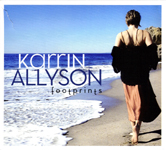
Footprints
Concord Records
By Butch Berman
BULLSEYE!! That’s exactly what
this NYC songstress scored with her newest release,
“Footprints,” on Concord Records. When they first signed her
around a decade ago, they knew they had someone special in their
midst. With this wonderful new CD, it’s apparent that Karrin has
become their precious little gem, and I mean that in a good way,
as she deserves all the acclaim she receives.
I’ve adored her music, and I
have enjoyed my schoolboy crush on her since we first met in
1995. You bet she’s cute and sexy, but it’s her swingin’
confidence behind her immense talent that really turned me on
the most. Watching her growth musically, on stage and
personally, has been a pleasure to behold. Yep, she’s that good.
Being a true player and
bandleader, besides her lovely voice, has gained Karrin much
respect in this biz from her peers as well the multitude of fans
the world over. Some have criticized her occasional
outspokenness towards her audiences regarding not conversing
during performances, but I’ve always thought she was right on.
Sometimes you have to teach people how to listen to jazz, not
only for those surrounding these rude-niks but for their own
good, as an appreciation of jazz is a proven healing entity
worthy of their attention. Karrin has earned her right to preach
for what’s right, most evident on “Footprints,” which I stand on
record as stating is her BEST ever, setting her own bar even
higher. Now dig this.
You can’t go wrong when:
-
You bring on board one of,
if not THE savviest jazz singers in its history, Nancy King.
You can’t go wrong when:
-
You add the legendary Jon
Hendricks to the mix, recreating the lost art of vocalise in
the traditions of Lambert, Hendricks and Ross, or France’s
Blue Stars featuring Blossom Dearie.
You can’t go wrong when:
-
You use drummer Todd Strait,
who has been with Karrin from her early KC days, despite his
move to Portland, Ore., and can probably out-swing any of
the NYC cats that she could have picked from. Her solidarity
with Todd makes for one tight recording unit, as Todd can
pick up on all of Ms. Allyson’s nuances and take it home in
spades. It’s a wise choice, indeed, by either Karrin or her
astute producers Nick Phillips and partner Bill McGlaughlin.
One of the city’s premier
bassists, Peter Washington, blends with Strait to lay down a
dynamite rhythm section augmented by pianist Bruce Barth, who’s
really come into his own in the past few years and just totally
cooks. Karrin found lyricist Chris Caswell, formerly with Paul
Williams, at Feinstein’s, a Big Apple cabaret hot spot, and his
clever new lyrics to some of the classic tunes chosen for this
project are just brilliant.
I may have placed the first
track, “Something Worth Waiting For (Con Alma),” in a different
slot, as I tend to like the first cut on all albums and CDs to
jump out at me a little more instead of being a little laid
back. It’s still a very pretty number, and all of the rest not
just shine brightly, but truly sparkle. Her stuff with Ms. King
is picture-perfect throughout. Frank Wess, as always, blows his
tenor sax to perfection. His signature tone captivates the songs
he’s on, as well as his flute playing on “But I Was Cool.”
I’d love to see this whole album
done live with this same line-up. It’s truly a work of art. Once
you pick up “Footprints,” you will know you stepped in the right
place at the right time. My wife, Grace, said she thought Karrin
looked the happiest she could remember on the cover and all the
rest of her photographs on the CD jacket. If I had just created
a masterpiece like this one, I’d be feeling mighty serene
myself. Bravo again.
top |
|
|
|
LAURA
CAVIANI
Going There
Caviani Music
By Butch Berman
The piano trio is a delicate
thing, kinda like cooking. Too much of this, not enough of that…
For all things created to come out right, sometimes it’s what
you leave out that makes it delicious. That’s exactly what
composer, arranger and pianist Laura Caviani has accomplished on
her new Minneapolis-based CD “Going There.”
A stunning photo of Laura graces
the cover, and her jazzy, self-produced tunes are as lovely as
is she. When I noticed she hired her dear friend and top-notch
musician in her own right Karrin Allyson’s rhythm section of
Topeka-born, Kansas City-bred bassist Bob Bowman and drummer
Todd Strait, I knew this puppy would fly. As a matter of fact,
it not only flies, it soars.
Caviani cleverly crafts each
selection, knowing how to use space and dynamics to perfection.
Todd and Bob are stone pros who weave in and out of Laura’s
nifty keyboarding, and set up a mosaic of sound. They’ve gigged
and recorded with the best—and each other—for decades, and it
shows. Their stone-cold accuracy in providing the perfect
accompaniment for the wide variety of fine compositions written
by Caviani is most admirable. Being on the playing side of the
biz for years, I can attest to the fact that no matter how
“great” you might be, if your band sucks, you suck. On the other
hand, if they cook you feel propelled to excel. In the case of
this aforementioned trio, when they’re all that hot… look out.
“Going There” isn’t a CD that
blazes, but of the “cool jazz” variety with just a touch of a
wistful melancholy that makes me wonder if Laura was going back
somewhere, visiting a musical reflection of days past. My fave
track, showing off her well-honed beboppish licks, is “In the
Interim,” which should have been the lead-off cut, for my money.
All other selections are enjoyable listening, with a catchy
vocal number entitled “Between the Lines,” utilizing a back-up
horn section for a nice change of pace.
The band really hits their
groove in a zone-like fashion on “The Gilded Cage,” which will
by then have you, the listener, in the palms of its hands on
this rather dreamy, but spirited jazz journey. Matthew
Zimmerman’s recording capabilities at Wild Sound Studios, in
Minneapolis, and Ms. Caviani’s production skills, are totally
copasetic and in sync. Contact her at
www.lauracaviani.com to purchase your own copy of “Going
There” and you’ll be “where it’s at,” too.
top |
|
|
|
ELDAR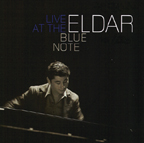
Live at the
Blue Note
Sony Classical
By Tom Ineck
We at the Berman Music
Foundation can say we knew Eldar when he had a last name. Since
he hit the big time, the young, hyper-virtuosic pianist has
dropped the second half of his moniker—Djangirov—presumably for
easier audience identification, at the behest of big-label
executives.
“Live at the Blue Note” is
Eldar’s second release on the Sony Classical imprint. He may
have lost a last name, but he has lost nothing in technique or
jaw-dropping speed. Recorded here at age 18, he remains as
astoundingly precocious as he did at his Topeka Jazz Festival
debut in 1998, at age 11.
Backed by longtime sideman Todd
Strait on drums and bassist Marco Panascia, Eldar roars out of
the gate like a young thoroughbred on the opener, “What Is This
Thing Called Love.” His sense of time and touch never falters as
he drives the tempo with amazing keyboard pyrotechnics.
In recent years, Eldar has also
proven himself an accomplished composer, and there are four such
originals here. “Someday” is a gorgeous ballad that allows the
pianist to explore the lush changes for nearly 10 minutes.
“Daily Living” bounds lightly over expansive chords, with
arpeggios accelerating wildly, then segueing into a drum solo
before returning for an exhilarating climax. “Sincerely” is
another heart-wrenching ballad distinguished by its stately,
classical voicing and sustained waves of sound.
Eldar demonstrates his affinity
for percussive, soul-jazz riffs with his lengthy variations on
Bobby Timmons’ bluesy “Dat Dere.” He begins “Besame Mucho” at an
appropriately dreamy tempo, gradually stepping outside the
familiar melody for some extended harmonic improvisations as the
trio ratchets the intensity, Strait switching from brushes to
sticks and Eldar synchronizing two-fisted block chords. The
performance is an object lesson in dynamics.
“Chronicle” is the most
extraordinary example here of Eldar’s composing and playing
abilities. Full of complicated stop-time passages and taken at a
precarious tempo, it harkens back to some of the more
mind-boggling feats of the young Keith Emerson, blurring the
lines between classical technique, jazz exploration and rock
audacity. Strait also contributes some stunning drum work.
The live setting is given a more
informal ambience by the interspersed guest appearances of two
trumpeters, Chris Botti on the romantic ballad “You Don’t Know
What Love Is” and Roy Hargrove on Monk’s “Straight, No Chaser.”
But, let’s face it, the reason we’re here is Eldar, last name or
no last name.
top |
|
|
|
JESSICA
WILLIAMS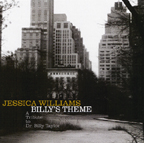
Billy’s
Theme
Origin Records
By Tom Ineck
Jessica Williams, the
underappreciated piano master of the San Francisco Bay area, has
taken a unique approach in her solo tribute to fellow piano
giant Dr. Billy Taylor. Rather than simply playing variations on
Taylor’s compositions, she has fashioned a very personal homage
with eight Taylor-inspired originals.
The stately chords, the gentle
stride in the bass register and the gospel feel of “Finally
Free” opens the proceedings with the dignity appropriate for
Taylor’s own graceful élan. Williams effortlessly varies tempo
and mood, telling a story rather than simply going through the
motions.
“Billy’s Theme No. 1” is built
on a series of chords and modulations reminiscent of Ellington’s
orchestral motives. Stretching beyond nine minutes, it allows
Williams to range widely in variations before returning to the
main theme. “The Soul Doctor” is a bluesy rumination pitting a
comping left-hand pattern against searching right-hand flurries.
Even more elemental is “Blues for BT,” a mid-tempo shuffle in
which the left hand remains anchored in the lower regions of the
keyboard while the right hand roams freely. Williams sensitively
explores the minor-key waltz motif on “Taylor’s Triumph,” with
lovely descending lines and occasional dissonant touches that
are as refreshing as a summer rainfall.
More than 20 minutes of this
generous CD is taken up by “Spontaneous Composition and
Improvisation No. 1” and “Spontaneous Composition and
Improvisation No. 2.” These tunes are so well conceived, so
carefully constructed and so brilliantly developed that it is
hard to believe they sprang full-blown in the moment. The closer
is “Billy’s Theme No. 2,” a return of the earlier melody and an
ideal showcase for Williams’ deft arpeggios and ringing tones at
both ends of the keyboard.
To give it the concert hall
fidelity that both Taylor and she favor, Williams placed the
microphones farther from the piano, allowing the keyboard’s full
transient overtones and deep bass tones to be heard.
As Williams says in the liner
notes, she intentionally chose a “less is more” approach over
the “flying fingers” style of so many contemporary keyboard
virtuosi. The dichotomy is immediately apparent when you compare
this relaxed, evocative outing with the frenetic display by the
young Eldar Djangirov on his latest recording. Perhaps the
realization that less is more is a lesson learned only with age
and maturity.
I was first made aware of
Williams when she played a trio date at Yoshi’s back in the
early 1980s. Despite her relative obscurity outside the Bay
area, Williams has nearly 30 CDs still in print. You are advised
to check them out.
top |
|
|
|
JOEY
DeFRANCESCO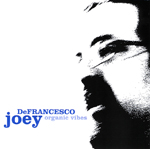
Organic Vibes
Concord Records
By Tom Ineck
“Organic Vibes” gallops out of
the gate like a Roman chariot race, with musicians charging
ahead while firmly in harness and working together. Joey
DeFrancesco’s “The Tackle” is the riotous, swinging opener, an
indicator of more good things to come.
Always energized, organist
DeFrancesco has rarely had an unsatisfactory recording, but this
is one of his best in years. Chalk it up to the inspired
collaboration with legendary vibraphonist Bobby Hutcherson, who
is much too rarely recorded in recent years. The light, ringing
tone of the vibes seems like the perfect sound-mate for the
brawnier Hammond B-3. And these two leaders on their respective
instruments seem ideally compatible.
Add to the mix Ron Blake on
tenor and soprano saxes and flute, guitarist Jake Langley and
longtime DeFrancesco sideman drummer Byron Landham, and you have
a formidable ensemble of musical giants. The capper is George
Coleman, who lends his classic tenor sound to two tracks.
Hutcherson’s familiar melody
“Little B’s Poem” is a nice vehicle for the front line of vibes,
flute and organ as they leap through the changes with obvious
glee. The 65-year-old vibraphonist carefully delineates the
beautiful changes of “I Thought about You,” then hands it off to
DeFrancesco, who contributes his usual jaw-dropping variations
before returning it to Hutcherson for the conclusion.
Everyone gets a workout on the
mid-tempo “Somewhere in the Night,” which is Coleman’s first
appearance on the CD. In his solo, he proves he still has a
powerful presence at age 71. DeFrancesco follows, in his full
Jimmy Smith-style mastery of the keyboard. “Down the Hatch” is
bluesy DeFrancesco burner that illustrates the rhythmic rapport
that the organist has with Landham after 16 years working
together.
The standard “Speak Low” is
taken at a frightening clip and serves as a showpiece for
Coleman, who deftly maneuvers through the rapid changes. The
drummer contributed the romantic ballad “JeNeane’s Dream.”
DeFrancesco holds back as Hutcherson and guitarist Langley
introduce the waltz-like tune in tandem.
“My Foolish Heart” finds
organist and vibraphonist pairing up in an exquisite reading of
this evergreen. DeFrancesco is especially sensitive to
Hutcherson’s long sustained passages and echoing tone.
top |
|
|
|
ROGER
DAVIDSON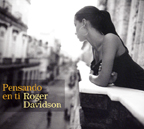
Pensando en ti
Soundbrush Records
By Tom Ineck
A classical pianist with an
eclectic interest in world music and Latin dance, Roger Davidson
brings off this collection of boleros and rumbas with aplomb and
sufficient authenticity to silence all doubters.
It certainly helps that Davidson
has surrounded himself with superb musicians, including drummer
Ignacio Berroa and bassist David Finck, in addition to flutist
Marco Granados, guitarist Francisco Navarro, trumpeter Kenny
Rampton and percussionist Pernell Suturnino. Together, they
create the irresistible rhythmic drive and melodic romanticism
inherent in these Latin song forms.
Recorded like a jazz album
rather than a classical session, the mood is relaxed and the
arrangements are uncomplicated, giving the musicians plenty of
space to express themselves. For example, Navarro delivers a
stunning guitar solo on the bolero “Somos Novios,” by the famous
bolero composer Armando Manzanero. “La Gloria Eres Tu,” by Jose
Antonio Mendez, has the muted trumpet passing the melody to the
flute, then to Davidson at the piano. The flute and guitar
improvise the introduction to “Mi Amor.”
Osvaldo Farres’ “Tres Palabras
(Three Words)” was a rare hit for the bolero genre back in 1946,
when the English version, retitled “Without You,” with lyrics by
Ray Gilbert, was sung by Andy Russell in the animated film
called “Make Mine Music.” Here it is accelerated to a rumba
tempo, getting the respectful treatment with Davidson stating
the theme, followed by an open trumpet passage and a stately
piano solo.
Another classic of the genre is
“Mi Dolor,” a tango written in 1931 by Carlos Marcucci. Here it
is transformed into an intoxicating bolero for piano and guitar.
Both bassist Finck and trumpeter Rampton (on muted horn) take
exhilarating solos on the uptempo “Rumba Feliz,” with Rampton
delivering an especially dazzling statement before Davidson
wraps it up with a nice piano solo.
Davidson owes melodic and
stylistic allegiance to Bill Evans, expressed here in his
version of Armando Manzanero’s “Esta Tarde Vi Llover,” which
Evans recorded in its American version, “Yesterday I Heard the
Rain.”
Davidson himself penned nine of
the 14 tunes here, proving his affinity for the rumba and
bolero. The similar song forms provide the perfect vehicles for
his lyrical keyboard style.
top |
|
|
|
JOHN McNEIL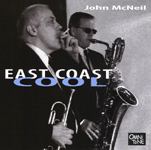
East Coast Cool
OmniTone
By Tom Ineck
Trumpeter John McNeil’s latest OmniTone recording did not arise
suddenly from a whim to mimic the legendary pianoless quartet of
Gerry Mulligan and Chet Baker, though the instrumentation is the
same. Never interested in merely duplicating someone else’s
sound, McNeil used the format as a template for his typically
uncompromising, contemporary approach to music.
It
took nearly a decade to bring the project to fruition. Soon
after Mulligan’s death in 1996, McNeil was asked to arrange some
of the baritone saxophonist’s compositions for a tribute
concert. In the process, he began to imagine the possibilities
of updating the sound with his own tunes and his own rhythm
section. Finally, in January 2004, McNeil went into the studio
with baritone saxophonist Allan Chase, bassist John Hebert and
drummer Matt Wilson. The result, “East Coast Cool,” contains
faint echoes of Mulligan and Baker’s so-called “West Coast Cool”
style, while charting a new and exciting musical terrain.
The
very nature of the pianoless quartet forces the players to
create their own harmonic language, since they can’t simply rely
on the keys to establish a rich harmonic backdrop for their solo
improvisations. This is where McNeil and company excel—working
out harmonies with great discipline and empathy, or dispensing
with them entirely, venturing forth with call-and-response
phrases, occasionally swerving dangerously into dark side
streets and back alleys, but always arriving at their
destination intact.
So
it is with “Deadline,” the careening opener that quickly sets
the pace and tone with stop-time precision, Wilson’s inventive
rhythmic punctuation and deft dialogue between McNeil and Chase.
“A Time to Go” is more reflective, almost introspective, and
“Brother Frank” has an ominous loping gait, aided by Hebert’s
reliable walking bass line.
Bernie Miller’s “Bernie’s Tune,” one of the rare tunes not
written by McNeil, gets an off-kilter treatment that seems to
alternately slow down and accelerate as Chase and McNeil trade
solo statements. Wilson’s spirited drumming is especially
impressive here.
“Delusions” is a classic McNeil invention, simultaneously
enticing and baffling the listener with its frantic changes. “Wanwood,”
on the other hand, is taken at a somber tempo that evokes
sadness. On “Internal Hurdles,” Wilson directs the trumpet-sax
interplay like a veteran cop directing traffic in downtown
Manhattan.
Don’t try to dance to “Waltz Helios,” a rhythmically precarious
venture. “Schoenberg’s Piano Concerto” bears little resemblance
to the original, but illustrates McNeil’s ability to adapt the
concepts of other composers to his own unique sound.
East, west, north or south, this is cool.
top |
|
|
|
JOE LOCKE &
THE MILT JACKSON TRIBUTE BAND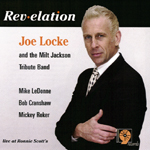
Rev-elation
Sharp Nine Records
By Tom Ineck
The
venerable Ronnie Scott’s jazz club in London is the setting for
Joe Locke’s soulful celebration of the music of the late, great
master of the vibraphone. For some 40 years, Milt Jackson’s
bluesy approach was the perfect counterbalance to pianist John
Lewis’ classical influences in the Modern Jazz Quartet. “Bags”
died in 1999, but his music and “good vibes” live on.
For
this outstanding tribute, recorded last April, Locke fronts an
exemplary quartet that includes three former Jackson
employees—pianist Mike LeDonne, bassist Bob Cranshaw and drummer
Mickey Roker, who filled in for Connie Kay when that drummer’s
declining health prevented him from touring with the MJQ in the
1990s. Together, Locke and company lend credibility, wit and
technical proficiency to this heartfelt project.
Jackson’s soulful tune “The Prophet Speaks” is the fitting
opener, giving everyone a chance to loosen up. Cedar Walton’s
hip arrangement of the standard “Young and Foolish” is the
perfect mid-tempo vehicle for Locke’s swinging pyrotechnics and
LeDonne’s breezy keyboard artistry. A Ray Brown arrangement
gives a Latin tinge to Burt Bacharach’s ballad “The Look of
Love.”
The
title track, penned by LeDonne, is a reference to Jackson’s
gospel influences and to another of his nicknames, “The
Reverend.” The soulfulness remains even when the tempo increases
on Horace Silver’s “Opus de Funk,” which also features a
masterful LeDonne solo on the Fender Rhodes keyboard.
“Close Enough for Love” is the only other ballad on this
recording. It gets the romantic treatment but, as always, the
blues feeling is never far away. Locke’s loping ode to Roker,
entitled “Big Town,” brings out the best in the percussionist’s
vast repertoire of licks, from subtle fills to intricate
stop-and-go phrases. Ray Brown is credited with “Used to Be
Jackson,” an uptempo bop number that ends the set in style.
One
hardly need mention the solid rhythmic support throughout this
exciting live performance. It is a given that Cranshaw and Roker
are in the upper echelon, masters of their craft. Otherwise,
they—and LeDonne—would not have been so integral to Jackson’s
band for the last decade of his performing life.
Stepping into the void left by Jackson’s passing was a daunting
task for Locke, but he pulls it off with a combination of
respect, class and his own inimitable sound.
top |
|
|
|
CRIMSON
JAZZ TRIO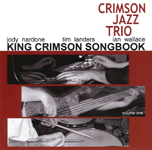
King Crimson Songbook, Vol. 1
Voiceprint
By Tom Ineck
It’s about time someone recognized the timeless quality of King
Crimson’s music and its relationship to cutting-edge jazz. The
seminal progressive rock band of the late 1960s continues to
record and perform under the leadership of founder-guitarist
Robert Fripp (2003’s “The Power to Believe” is the latest studio
release) and remains a viable contributor to mature,
contemporary music. Of whom else can this be said?
With its recording debut, the Crimson Jazz Trio pays
long-overdue tribute to the sophisticated sounds of the band
that introduced “21st Century Schizoid Man” in 1969!
It is fitting that the trio opens the recording with its own
jazzy rendition of this classic.
Pianist Jody Nardone, bassist Tim Landers and drummer Ian
Wallace are more than equal to the task, reinventing all the
tunes here in their own style, without sacrificing any of the
urgency, audacity, astonishing technique and twisted wit of the
originals. Nardone’s lushly harmonized chord progressions and
straight-ahead bop lines set the standard for Landers’ fluid and
thunderous fretless bass ruminations and Wallace’s stately,
colorful and pungent percussion.
Landers’ playing is especially lyrical on “Three of a Perfect
Pair,” from the 1984 release of the same name. The intensity
grows as his booming lead statement is followed by a pounding
piano excursion, aided and abetted by Wallace. “Catfood” is a
quirky blues number from KC’s second release, 1970’s “In the
Wake of Poseidon.” The canine vocalizing of “Hagi the dog” adds
the appropriate comedic touch.
From 1974 comes “Starless,” a melodic gem that is given a
gorgeous 10½-minute treatment here. “Ladies of the Road” is a
swinging little number from the 1971 release “Islands.” Nardone
and the others really work out on this one. The trio slows down
again for the ballad “I Talk to the Wind,” also from “Poseidon”
and perhaps the most beautiful melody in the entire KC songbook.
“Red” is an edgy, off-kilter 1974 tune that sends the trio into
hyper-drive in a dazzling technical display. The closer is
“Matte Kudasai,” a lovely Adrian Belew composition from KC’s
1981 release “Discipline.” Its exotic beauty is heightened by
Landers in a soaring bass solo and by Nardone in a romantically
lush piano solo, reminiscent of Keith Jarrett’s yearning sound.
Wallace keeps impeccable time and adds powerful accents on the
cymbals.
After listening to “King Crimson Songbook, Vol. 1,” King Crimson
fans—and jazz fans—can only ask, “When can we expect volume
two?”
top |
|
|
|
GREG ABATE
QUINTET
Monsters in the Night
Koko Jazz Records
By Tom Ineck
Aside from their evocatively
creepy titles, the nine tunes contained herein under the banner
“Monsters in the Night” have little in common with the music of
horror film soundtracks or other popular mythology. They are,
however, representative of Greg Abate’s ability as composer,
arranger, leader and player.
Whether on alto or tenor sax or
flute, Abate always rides the hard-bop edge, and fans of his
style will be pleased that he continues that tradition here with
tunes like the driving opener, “Dracula.” Abate admirably shares
the front-line with trombonist Artie Montanaro, while pianist
Paul Nagel, bassist Bill Miele and drummer Vinny Pagano aide and
abet the insistent rhythm. For contrast, Abate switches to flute
for the gentle waltz tribute to the “Bride of Frankenstein.”
The combo is comprised of
first-rate accompanists who also solo with taste and expertise.
The title track is a swinging shuffle that is elevated by a fine
piano solo. Montanaro kicks off “Dr. Jekyll” with a brawny,
confident solo, inspiring Abate’s lively entrance on alto sax.
Miele shines while navigating the tricky changes of “In the
Woods at Night.”
With titles like “Frankenstein,”
“Dr. Jekyll/Mr. Hyde,” “Bride of Frankenstein,” and “Pentagram,
The Wolfman” some listeners may bemoan the single-minded
thematic obsession with the horror genre and the lack of
familiar jazz standards. Abate, however, knows the game well
enough to vary tempo, arrangement and tone just enough to make
things interesting. He also is a highly skilled composer with a
quirky sense of humor, penning “Transylvania 6-5000” (no
relation to Glenn Miller’s “Pennsylvania 6-5000”) and cleverly
ending the session with “Igor’s Revenge,” another vehicle for
Abate’s fluent flute-playing.
At more than 65 minutes,
“Monsters in the Night” is a generous sampling of Abate’s
post-bop inclinations, with all participants given ample room to
move. Rather than anything spooky, the title must simply refer
to these “monster” musicians at work and at play with the music
they love.
top |
|
|
|
JOE
CARTWRIGHT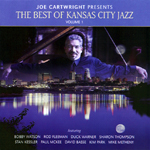
The Best of Kansas City Jazz
Vol. 1
Joe Cartwright Records
By Tom Ineck
After years of leading the Best of Kansas City Jazz Series in
the Oak Bar at the Fairmont Kansas City, pianist Joe Cartwright
had compiled some 24 hours of live, recorded music. With “The
Best of Kansas City Jazz, Vol. 1,” he begins to share some of
those memorable moments with those of us who were unable to
attend.
Recorded between February and July 2004, each of the 10 tracks
features a prominent KC jazz artist, with Cartwright himself
confidently fronting the rhythm section with his impeccable
keyboard work on all but one. For David Basse’s showcase, Lionel
Hampton’s “Red Top,” the singer brought along his own
outfit—pianist Oscar Williams, bassist Bryan Hicks and drummer
Bill Goodwin.
Guitarist Rod Fleeman brings his ebullient style to “East of the
Sun,” and virtuosic alto saxophonist Bobby Watson turns Charlie
Parker’s “Little Suede Shoes” every which way but loose. With
his soulful, urbane vocal style, Duck Warner turns Memphis
Slim’s “Every Day I Have the Blues” into a sophisticated blues
number. Trumpeter Stan Kessler expertly navigates Horace
Silver’s difficult “Nutville” with brassy flair, taste and
imagination.
Trombonist Paul McKee shows his warm tone and considerable
technique on Bill Evans’ “Time Remembered.” Singer Sharon
Thompson testifies with gospel-tinged soulfulness on “Teach Me
Tonight,” which also features a bluesy solo by Cartwright. Kim
Park caresses the wistful changes of “We’ll Be Together Again”
with his fluent alto saxophone, and trumpeter Mike Metheny
interprets Jobim’s “One Note Samba” on the EVI (electronic valve
instrument).
Cartwright’s authoritative presence is felt throughout this
recording, but he really gets a chance to shine on John Lewis’
classic “Django,” with bassist Gerald Spaits and drummer Ray
DeMarchi. A veteran of late-night KC jam sessions, he can comp
and lend harmonic and rhythmic support to any occasion, but his
prodigious playing talents are often understated in his role as
accompanist. The alternating tempos and moods of “Django”
perfectly illustrate his technical accomplishment, sensitivity,
and improvisational skills.
When the spotlight is on the featured soloists, it’s easy to
overlook the essential rhythm players who make them sound so
good. Spaits provides the bass foundation on five tracks, Bob
Bowman on two and Tyrone Clark on two. DeMarchi’s solid and
sensitive support on drums can be heard on nine tracks.
top |
|
|
|
DOUG TALLEY
QUARTET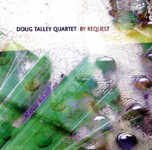
By Request
Serpentine
By Tom Ineck
With its fourth CD on the Serpentine label, the Doug Talley
Quartet continues to expand its repertoire and its tonal
palette, adding horns and strings in a live recording last year
at Valley View United Methodist Church in Overland Park, Kan.
Applied to a set largely comprised of familiar standards, the
lush arrangements are reminiscent of similar projects, including
the seminal “Charlie Parker with Strings.”
Utilizing tenor sax, soprano sax and bass clarinet, Talley
creates subtle shifts in mood and color. Like a jazz Picasso, he
dabbles in mixed media and paints in broad swashes of sound from
the accompanying ensemble of brass, reeds and classical strings.
But it is the core quartet of longtime colleagues that make it
all work so well—Talley on reeds, Wayne Hawkins on keys, Tim
Brewer on bass and Keith Kavanaugh on drums. All contribute
arrangements, assuring that the group dynamic is always at work.
Cole Porter’s sophisticated “Get out of Town” begins with a lush
backdrop of strings before Talley states the theme on soprano.
Hawkins, Brewer and Kavanaugh all get a chance to express
themselves before the tune comes to a close. Talley switches to
tenor sax for an interesting take on “Take Five,” which is also
a showcase for Hawkins. The lilting Bill Evans ballad “Very
Early” gets a gorgeous lush treatment, as does Coltrane’s “Giant
Steps,” with Talley again on soprano.
“Donna Lean” is, of course, a variation on Parker’s bop classic
“Donna Lee.” The quartet draws on the Richard Rodgers songbook
for “I Didn’t Know What Time It Was,” and Ellington is well
represented by loving renditions of “In a Sentimental Mood” and
a closing romp on “Caravan.”
The
Talley quartet—augmented by trumpeter Al Pearson and alto
saxophonist Gerald Dunn and backed by Shannon Finney on flute
and piccolo, Elena Lence Talley on clarinet, Marvin Gruenbaum,
Robin Prinzing and Brad Athey on violins, Monty Carter on viola
and Les Mengel on cello—has taken another leap forward in its
continuing exploration of jazz and all its permutations.
top |
|
|
|
BRYAN
McCUNE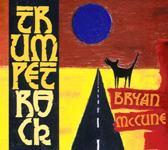
Trumpet Rock
Microscopic Records
By Tom Ineck
From his hometown of Lincoln, Neb., trumpeter Bryan McCune’s
travels have taken him to Chapel Hill, N.C., Washington, D.C.,
and Baltimore, Md., before his return to North Carolina, where
he hooked up with a coterie of adventurous musicians to create a
blend of jazz, folk and rock influences.
The
result is “Trumpet Rock,” a fascinating collection of mostly
McCune originals melding jazz instrumentation, a folk esthetic
and an insistent backbeat. After an untraditional version of the
traditional folk song “Wayfaring Stranger,” the band launches
into a soulful “Revival on North Evergreen,” featuring Mark
Daumen on tuba, Jim Crew on organ and McCune on cornet,
flugabone (a cross between flugelhorn and trombone) and
accordion.
The
title track begins gently with acoustic resonator guitar,
trumpet and Rick Lassiter on upright bass, and then launches
into a fuzz-toned, electric rock rumble, McCune doubling on lap
steel guitar. “Brudog’s Lament” is mournful, indeed, as it pits
cornet, organ, sliding steel guitar and Wayne Leechford’s
baritone sax in a slow, dirge-like anthem.
Cosmic allusions are obvious in “Martian Eyes,” with its farting
tuba, spacey keyboards, and cornet loops. Its offbeat and
audacious changes evoke the music of Frank Zappa. A gentle samba
rhythm pervades “Ombah,” which comes closest to resembling a
conventional jazz tune. Nearly 10 minutes long, it allows Crew
to stretch out in a wonderful piano solo, followed by McCune on
cornet, and Lassister on bass. Francis Dyer is the versatile
drummer throughout these sessions, which come to a soulful
conclusion with “Apostle of Droll.”
By
the way, besides being an excellent trumpeter and cornetist,
McCune also plays assorted electronics, guitars, keyboards,
accordion, percussion and that aforementioned flugabone. Much of
this recording simply beggars description, leaving this writer
at a loss for words to either make stylistic comparisons or cite
precedents. Whatever it is, I like it.
top |
|
|
|
ALEX GRAHAM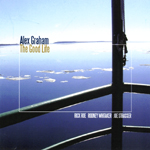
The Good Life
Origin Records
By Butch Berman
Origin Records has
been putting out a ton of stuff these days, and mostly good
stuff…real good, in fact. It’s more than I can ever listen to,
and if you talented cats in Seattle are reading this…I really
appreciate it. As a matter of fact, one of my favorite “new”
guys is now with you, and his name is Alex Graham.
Hold on to this
dude. He’s truly on his way to making an indelible mark in the
jazz world as on of the upcoming monsters. Yup, he’s that good.
I very favorably
reviewed his first CD, “Grand,” in the November 2005 newsletter
and found it to be so, like its title…grand. That was more of a
New Orleans-styled jazzy r&b band with a cool singer and, as
always, Alex’s inspired signature horn, with such luscious tone
and impeccable phrasing. It’s not often that an artist’s second
effort will impress as much as my introduction to him or her,
especially if it’s really a killer debut out of the chute. With
“The Good Life” and an entirely different back-up ensemble, Alex
Graham has done it again, and in spades. Recorded back in 1998,
this is truly a dynamite piece of work from beginning to end. I
know that when, right after I listen to a new CD, I immediately
have to hear it again before checking out another musician’s
hopeful entry lying in wait among so many others.
It’s another
no-frills, straight-ahead jazz album played to perfection, and a
song selection to match. Alex on alto, flute and clarinet is
brilliantly supported by this trio of solid senders. A newcomer
to me, Rick Roe at the piano is simply a delight with his
understated comping that still
speaks mightily. That mega-chopster
bassist Rodney Whitaker walks you
into the next stratosphere and is so connected to drummer Joe
Strasser on this session, you’d
think they were musical Siamese twins... tight, man, tight. This
triple-threat trio becomes this Hummer of a magic carpet for Mr.
Graham to float and soar above… and does he ever!
There are two
originals and four covers, including one of the prettiest
versions of “I Had the Craziest Dream” that has ever been
recorded. This is an above-standard standard, by all means. The
average length of each track is nearly 10 minutes, enough time
for these timeless cats to really stretch and blow and present
you with one of best jazz albums of 2005-6, even if it was
recorded nearly eight years ago. It’s way better late than
never, and “The Good Life” will be required listening for the
ages.
top |
|
|
|
DAVID GIBSON
The Path to
Delphi
Nagel-Heyer Records
By Butch Berman
Interesting…the two
main CDs I picked out to review for this issue of Jazz
both have Joe Strasser at the drum
helm. This cat’s good, and if you’re going to launch the beat
behind the likes of trombonist David Gibson, you’d better be.
Gibson’s new creation, “The Path to Delphi,” on Nagel-Heyer
Records is a complete cooker, and besides his most ample chops,
showcases the thought-provoking songwriting ability of Mr.
Gibson. Like a rocket ship taking flight, the title track
provides the first stage of motion, and by the time this
wondrous work closes with David’s “Prometheus’
Peace,” you’re in orbit.
This swinging crew
of “jazz astronauts,” including Randy
Brecker on trumpet and flugelhorn, Wayne
Escoffery on soprano saxophone, Rick
Germanson at the keys, bassist
Dwayne Burno and the previously mentioned drummer, Mr.
Strasser, literally tear this puppy
up. This is a true jazz experience, which these days is a
pleasure to behold for some of us old be-boppish
purists.
David, in his liner
notes, speaks of searching for the truth in his music, and in
this case that’s no lie. Recorded in NYC in 2004, this release
takes hold of all your pleasure centers. Yearning, urging and
caressing your senses while keeping your feet moving, “The Path
to Delphi” is truly a mind journey that you can also feel within
your body. Everyone played their butts off, yet this musical
story encompasses the usage of space, inner and outer, and
everything just seems to fit. Try this one on for yourself, and
beat a path to your favorite record outlet for “The Path…”
Repeated listening will be mandatory.
A major league
thank-you goes out to David Gibson for keeping the jazz
tradition alive with his horn, for his musical outpouring, and
for just keeping it so real. Truth…it is!
top |
|
|
|

